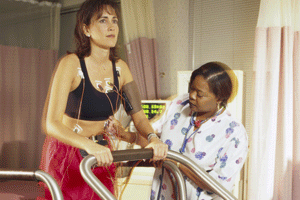![]()
Blog @ SunTech
Advice from the BP Measurement Experts
Top 7 Reasons You Should Be Using Automated Blood Pressure for Cardiac Stress Testing
 As any cardiologist will tell you, a cardiac stress test is a fundamental step to diagnosing a multitude of heart conditions and is a necessary tool for any cardiac care facility. The average cardiac stress test lab contains ECG stress systems, Echocardiogram machines, treadmills, ergometers and …. manual blood pressure gauges? With all of this automated equipment that allows us to remove variability and minimize inherent patient risk, why are we still trying to take blood pressures manually during a stress test?!
As any cardiologist will tell you, a cardiac stress test is a fundamental step to diagnosing a multitude of heart conditions and is a necessary tool for any cardiac care facility. The average cardiac stress test lab contains ECG stress systems, Echocardiogram machines, treadmills, ergometers and …. manual blood pressure gauges? With all of this automated equipment that allows us to remove variability and minimize inherent patient risk, why are we still trying to take blood pressures manually during a stress test?!
...why are we still trying to take blood pressures manually during a stress test?! Although there are plenty of automated blood pressure (BP) monitors on the market, most of these will not work in the high motion environment of a stress lab. Only BP monitors with motion tolerant technology designed specifically to handle the noise and motion of patient exercise are able to accurately measure BP during a stress test. The ideal automated stress BP monitor is one that can distinguish between the noise artifacts of the stress lab environment and the patient’s Korotkoff sounds (K-sounds). It is also important for the automated monitor to take readings at the correct time, automatically, based on the protocol being used. With this type of solution in mind, we felt obligated to list the top 7 reasons why you should automate your blood pressure measurements during cardiac stress testing.
- Patient Safety: As patient safety is always the number one priority, automated blood pressure measurement allows you to focus on your patient during a cardiac stress test instead of being distracted with the detailed task of taking manual blood pressure measurements. Automated stress BP allows for the stress technician(s) to focus on monitoring the patient’s ECG for heartbeat irregularities and observing their patient’s body language for fatigue in order to prevent a fall.
- Hard to Hear K-sounds: It is difficult to take manual blood pressure measurements in noisy environments. The noise of foot strikes, arm/body movement and of the treadmill itself make it very difficult to hear K-Sounds through the stethoscope, often resulting in inaccurate BP readings.
- Lots of Arm Movement: During a cardiac stress test, the patient is typically walking and/or running. The resulting arm and body movement makes it difficult to hold the patient’s arm still so that a manual BP measurement is even possible. With automated stress BP measurement, this is no longer an issue.
- Exercise Testing Stage Accuracy: In a Bruce Protocol, an accurate manual BP reading at stage 4 and beyond often becomes a guess. During a stress test, the goal is to reach the maximum heart rate, which is different for every person based on age and physical condition. A patient is usually jogging/running by stage 4, meaning there is a lot of movement making it extremely hard to perform a manual BP measurement. Automated BP measurement reduces these physical limitations by overcoming motion artifact and producing an accurate BP measurement during any stage of the Bruce protocol.
- Transcription Error Reduction: Automated BP measurements can be transmitted back to the stress system and automatically recorded in the patient test record thus reducing the possibility of transcription errors.
- Reliable Timing of BP Measurements: Automated BP measurements can be programmed to be taken at the same time, every time (e.g., a reading every 2 minutes at each Bruce Protocol stage). Therefore, the clinician is able to focus on the patient, rather than watching the clock and trying to remember when to take the reading.
- One-Time Cuff Placement: For manual BP measurements, a stress technician is often applying and removing the cuff at every Bruce protocol stage when a BP measurement is needed. In this situation, there is a strong possibility of improper cuff placement. For automated BP measurements, the cuff remains on the patient for the duration of the stress test, thus eliminating the hassle of reapplying a cuff, and reduces both measurement variability and the risk of improper cuff placement.
Cardiac stress testing is a proven method for assisting in the diagnosis of heart disease, evaluating cardiac function (i.e.: abnormal rhythm) and showing evidence of ischemia. Monitoring a patient’s blood pressure during stress testing is a vital part of the procedure. However, the noise and high motion associated with these tests presents many difficulties when trying to manually measure BP. Automated stress BP monitors that have been designed specifically to address and overcome these difficulties can help remove the inherent sources of error with manual BP measurement and allow clinicians to maintain focus on their patient’s safety. Now ask yourself again, why are you still trying to take manual blood pressures during a stress test?
We’d love to hear about the difficulties and challenges you’ve experienced with trying to take manual BP readings during a stress test. Please share your comments below.
Interested in getting more SunTech news, product info, as well as
tips, tricks, and insights from BP experts?
Sign up to get fresh content delivered direct to your inbox.



